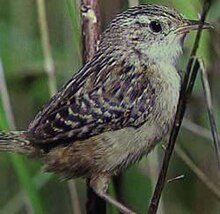Sedge wren
| Sedge wren | |
|---|---|
 |
|
| Scientific classification | |
| Kingdom: | Animalia |
| Phylum: | Chordata |
| Class: | Aves |
| Order: | Passeriformes |
| Family: | Troglodytidae |
| Genus: | Cistothorus |
| Species: | C. platensis |
| Binomial name | |
|
Cistothorus platensis (Latham, 1790) |
|
| Synonyms | |
|
Cistothorus stellaris |
|
Cistothorus stellaris
The sedge wren (Cistothorus platensis) is a small songbird of the wren family. It was formerly known as the short-billed marsh wren, and in South America is often known as the grass wren. There are about 20 different subspecies which are found across most of the Americas. Some of these forms may be separate species that could be split in the future.
Adults have brown upperparts with a light brown belly and flanks and a white throat and breast. The back has pale streaks. They have a dark cap with pale streaks, a faint line over the eye and a short thin bill. They are one of the smallest species of wren at 10–12 cm (4–4.5 in) and 10–12 g (0.35–0.42 oz).
In North America, their breeding habitat is wet meadows and marsh edges of eastern North America and central Canada. The nest is a round lump attached to low vegetation, entered from the side; it is usually well-hidden. The male often builds several unused nests in his territory; he may puncture the eggs of other birds nesting nearby. In South America, they are associated with very different habitats, principally páramo at very high elevations (3000 meters and above).
North American populations migrate to coastal areas in the Southeastern United States, and the entire Gulf Coast south through eastern Mexico.
These birds forage low in vegetation, sometimes flying up to catch insects in flight. They mainly eat insects, also spiders.
The song of the male in North American populations is a rattling trill. The song of Central and South American forms is far more variable.
This bird's numbers are declining, possibly due to habitat loss.
...
Wikipedia

